EPHIN Rates v Sensor Temperature (5EPHINT) 2012-09-01 to 2013-02-09
As we continue to relax the Mission Planning Guideline that covers the
EPHIN Thermal Limit, we need to trend the EPHIN performance to
monitor for unexpected changes in performance. The plots here show
the trends observed during the period from 2012-09-01 to
2013-02-09. During this interval the TEPHIN planning limit started
at 138 degF and was raised to 141 degF on 2012-09-06 and to 144
degF on 2012-12-06.
EPHIN data were selected for times outside the rad-zone, during the
nominally scheduled time with RadMon enabled. Data from times of
elevated solar activity have not been excluded.
The behavior of the data from the time interval covered here is
similar to that of the previous interval examined (2011-07-17 to 2012-09-01).
EPHIN E150 Coincidence Rate
The E150 rate shows more of the anomalous behavior first observed
during the Normal-Sun time of the CTU TLM-Processor
reset. This anomalous behavior led to halting the use of the
E150 channel for safing within RadMon.
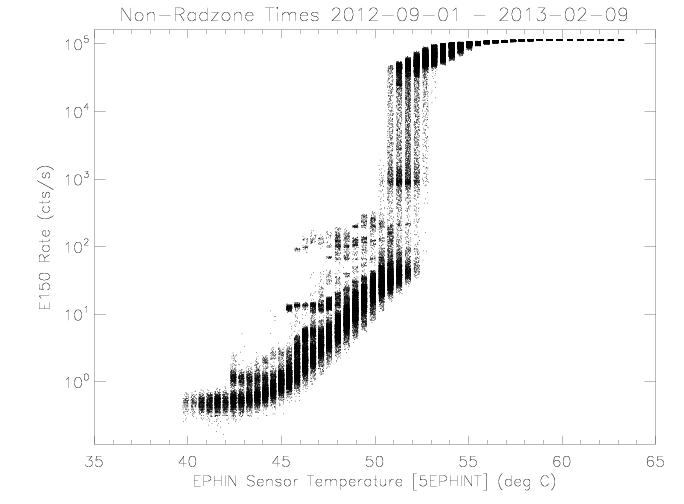
|
| Figure 1: EPHIN E150 coincidence channel rate vs EPHIN
sensor temperature The sensor temperature values have a
small, uniformly-distributed random valued added for
display purposes.
|
E1300 Rate
The E1300 rates show drops associated with higher EPHIN sensor
temperatures. The decrease in rate with higher temperature is due
to a decrease in detector C sensitivity as the temperature
increases. There is no rate increase in conjunction with the
detector C rate increase for temperatures above ~55.5 degC since
the signals are not in coincidence with those from other detectors.

|
| Figure 2: EPHIN E1300 coincidence channel rate vs EPHIN sensor
temperature, similar to figure 1.
|
Detector B0 (Center Segment)
The detector B0 rate increases are similar to the increases in the E150 rate as expected
given that the B0 signal is the dominant component of the E150
coincidence channel. The anomalous rates in the B0 detector are
what create the anomalous E150 rates.
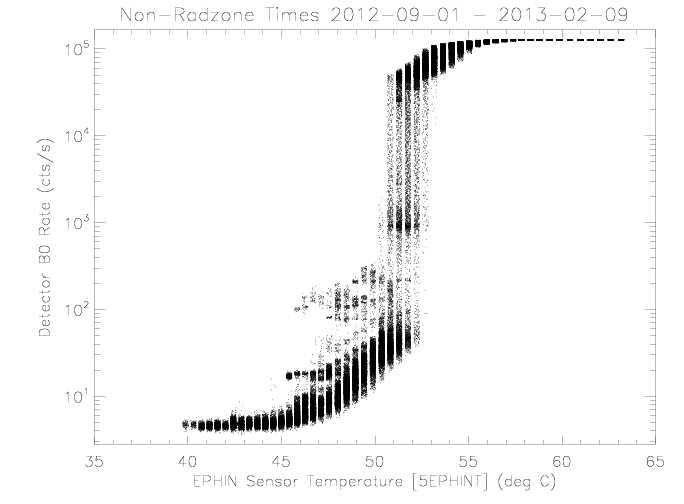
|
| Figure 3: EPHIN detector B0 rate vs EPHIN sensor
temperature, similar to figure 1.
|
Detector C
The detector C rate decreases with increasing sensor temperature above
roughly 43 degrees C. This behavior is the same as observed prior
to setting detector A failure-mode on. The decrease in rate
implies a decreased sensitivity to particles and is due to a
lower voltage across the detector. The upturn in the rate above
55.5 degC (similar to detector B0) is likely due to leakage current.
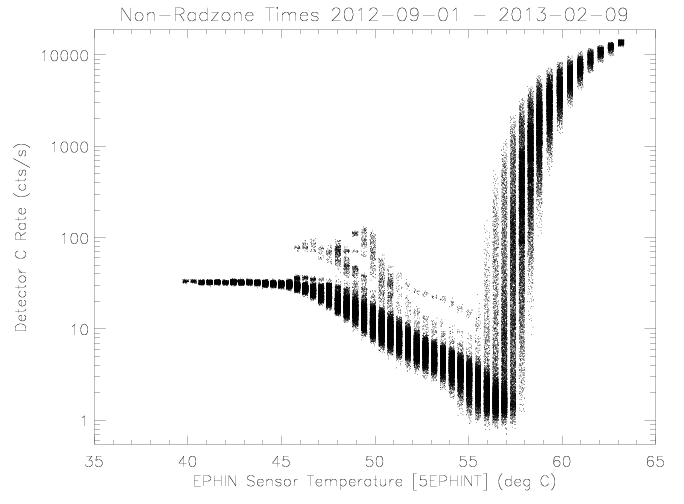
|
| Figure 4: EPHIN detector C rate vs EPHIN sensor
temperature, similar to figure 1.
|
Detector D
The detector D rate decreases with increasing sensor temperature above
roughly 50 degrees C, somewhat higher than detector C. As with
detector C, the decrease in rates implies a decreased sensitivity
to particles. The higher temperature of the on-set of the decrease
is consistent with the different detector thickness
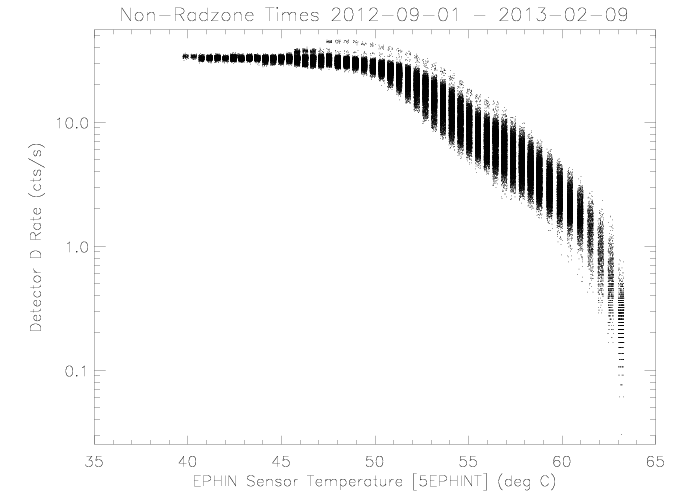
|
| Figure 4: EPHIN detector D rate vs EPHIN sensor
temperature, similar to figure 1.
|
Detector E
The detector E rate decreases with increasing sensor temperature above
roughly 50 degrees C, similar to detector D. As with
detectors C and D, the decrease in rates implies a decreased sensitivity
to particles.
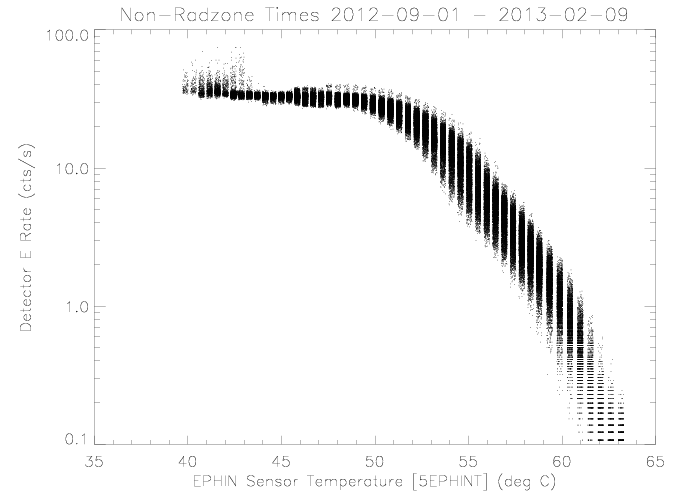
|
| Figure 4: EPHIN detector E rate vs EPHIN sensor
temperature, similar to figure 1.
|
Detector F
The detector F rate shows an increase as the rate exceeds roughly 53
degrees C. This may be due to increasing noise that would be
reflected in a higher leakage current. Unfortunately, the ceiling on the
telemetry reading for the leakage current has been reached at 48
degrees C.
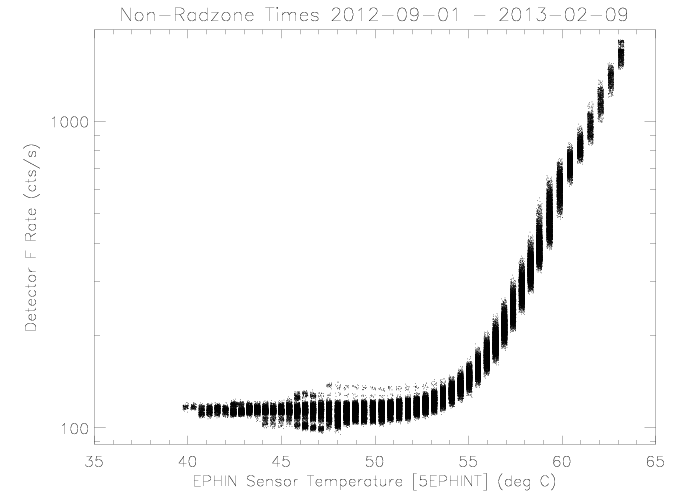
|
| Figure 4: EPHIN detector F rate vs EPHIN sensor
temperature, similar to figure 1.
|
Mike Juda
Last modified: Fri Feb 15 10:58:49 EST 2013







